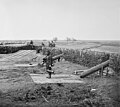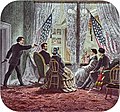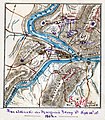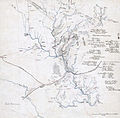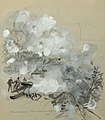Portal:American Civil War
 |
 |

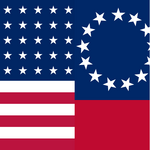
The American Civil War (1861–1865) was a sectional rebellion against the United States of America by the Confederate States, formed of eleven southern states' governments which moved to secede from the Union after the 1860 election of Abraham Lincoln as President of the United States. The Union's victory was eventually achieved by leveraging advantages in population, manufacturing and logistics and through a strategic naval blockade denying the Confederacy access to the world's markets.
In many ways, the conflict's central issues – the enslavement of African Americans, the role of constitutional federal government, and the rights of states – are still not completely resolved. Not surprisingly, the Confederate army's surrender at Appomattox on April 9,1865 did little to change many Americans' attitudes toward the potential powers of central government. The passage of the Thirteenth, Fourteenth and Fifteenth amendments to the Constitution in the years immediately following the war did not change the racial prejudice prevalent among Americans of the day; and the process of Reconstruction did not heal the deeply personal wounds inflicted by four brutal years of war and more than 970,000 casualties – 3 percent of the population, including approximately 560,000 deaths. As a result, controversies affected by the war's unresolved social, political, economic and racial tensions continue to shape contemporary American thought. The causes of the war, the reasons for the outcome, and even the name of the war itself are subjects of much discussion even today. (Full article)
Lafayette Square (formerly Court House Park or Courthouse Square) is a park in the center of downtown Buffalo, Erie County, New York, United States, that hosts a Civil War monument. The block, which was once square, is lined by many of the city's tallest buildings. The square was named for General Lafayette, who visited Buffalo in 1825.
The square was part of the original urban plan for the city as laid out by Joseph Ellicott in 1804. Its eastern edge has long been defined by important civic structures; first, the Erie County Courthouse, followed by the original Buffalo & Erie County Public Library. Presidential history was made in Lafayette Square when former United States President Martin Van Buren received the Free Soil Party nomination for the 1848 election. President-elect Abraham Lincoln also spoke at the square. (Full article...)

The New Mexico Territory, comprising what are today the U.S. states of New Mexico and Arizona, as well as the southern portion of Nevada, played a small but significant role in the trans-Mississippi theater of the American Civil War. Despite its remoteness from the major battlefields of the east, and its being part of the sparsely populated and largely undeveloped American frontier, both Confederate and Union governments claimed ownership over the territory, and several important battles and military operations took place in the region. Roughly 7,000-8,000 troops from the New Mexico Territory served the Union, more than any other western state or territory.
In 1861, the Confederacy claimed the southern half of the vast New Mexico Territory as its own Arizona Territory and waged the ambitious New Mexico Campaign in an attempt to control the American Southwest and open up access to Union-held California. Confederate power in the New Mexico Territory was effectively broken when the campaign culminated in the Union victory at the Battle of Glorieta Pass in 1862. Although the Confederacy never attempted another invasion of the region, its territorial government continued to operate out of Texas, with Confederate troops marching under the Arizona flag until the end of the war. (Full article...)
James Bennett McCreary (July 8, 1838 – October 8, 1918) was an American lawyer and politician from Kentucky. He represented the state in both houses of the U.S. Congress and served as its 27th and 37th governor. Shortly after graduating from law school, he was commissioned as the only major in the 11th Kentucky Cavalry, serving under Confederate Brigadier General John Hunt Morgan during the American Civil War. He returned to his legal practice after the war. In 1869, he was elected to the Kentucky House of Representatives where he served until 1875; he was twice chosen Speaker of the House. At their 1875 nominating convention, state Democrats chose McCreary as their nominee for governor, and he won an easy victory over Republican John Marshall Harlan. With the state still feeling the effects of the Panic of 1873, most of McCreary's actions as governor were aimed at easing the plight of the state's poor farmers.
In 1884, McCreary was elected to the first of six consecutive terms in the U.S. House of Representatives. As a legislator, he was an advocate of free silver and a champion of the state's agricultural interests. After two failed bids for election to the Senate, McCreary secured the support of Governor J. C. W. Beckham, and in 1902, the General Assembly elected him to the Senate. He served one largely undistinguished term, and Beckham then successfully challenged him for his Senate seat in 1908. The divide between McCreary and Beckham was short-lived, however, and Beckham supported McCreary's election to a second term as governor in 1911. (Full article...)
-
Military execution of the conspirators in the Abraham Lincoln assassination
-
The original sketch of Sherman in South Carolina: The burning of McPhersonville, at and by William Waud
-
Atlanta roundhouse ruin at History of Atlanta, by George Barnard
-
Lithographic facsimile of the Bixby letter, by Huber's Museum
-
Quaker guns, by George Barnard and James F. Gibson
-
Siege of Yorktown, by James F. Gibson
-
Confederate casualties at Chancellorsville during the American Civil War, by the National Archives and Records Administration
-
Andersonville survivor
-
George Armstrong Custer, by George L. Andrews
-
Francis B. Spinola, Brigadier General for the Union in the American Civil War, and Congressman from New York
-
The Chickahominy – Sumner's Upper Bridge at Peninsula campaign, by William McIlvaine
-
Abraham Lincoln's private secretary and biographer John Hay
-
Richmond, Virginia after the American Civil War
-
The burning of Columbia at Columbia, South Carolina in the American Civil War, by William Waud
-
The print version of Sherman in South Carolina: The burning of McPhersonville at McPhersonville, South Carolina, by William Waud
-
United States President (and former Brigadier-General) Benjamin Harrison
-
Daniel McCallum, by the Brady National Photographic Art Gallery
-
Andersonville Prison at Andersonville National Historic Site, by John L. Ransom
-
Allan Pinkerton, President Lincoln, and John A. McClernand in 1862 by Alexander Gardner
-
President Rutherford B. Hayes was the 19th President of the USA
- ... that Justus H. Rathbone, founder of the Knights of Pythias, served as a hospital steward during the American Civil War?
- ... that Carter Moore Braxton fought for the Confederacy throughout the American Civil War and, according to one report, had seven horses killed under him but avoided any wounds?
- ... that after the Little Rock campaign, Union forces held three-quarters of Arkansas?
- ... that Chinese-born Joseph Pierce enlisted as a Union Army soldier, fought at the Battle of Gettysburg during the American Civil War, and was made a corporal?
- ... that some Confederate bullets were sourced from a silver mine?
- ... that Colonel Bradley Winslow was brevetted by US president Abraham Lincoln for "brave and gallant conduct" during the siege of Petersburg in the American Civil War?
- Attention needed
- ...to referencing and citation • ...to coverage and accuracy • ...to structure • ...to grammar • ...to supporting materials
- Popular pages
- Full list
- Cleanup needed
- The West Tennessee Raids
- Requested articles
- James Ashby (soldier) • Benjamin D. Fearing • James B. Speers • Charles S. Steedman • Battle of Barton's Station • Lawrence P. Graham • Frederick S. Sturmbaugh • Davis Tillson • Action at Nineveh (currently a redirect) • International response to the American Civil War • Spain and the American Civil War • Savannah Campaign Confederate order of battle • Native Americans in the American Civil War (currently disambiguation after deletion) • Battle of Lafayette • Battle of Sunshine Church • Requested American Civil War Medal of Honor recipients
- Expansion needed
- Battle of Boonsborough • Battle of Guard Hill • Battle of Rice's Station • Battle of Simmon's Bluff • Battle of Summit Point • Charleston Arsenal • Edenton Bell Battery • First Battle of Dalton • Blackshear Prison • Edwin Forbes • Hiram B. Granbury • Henry Thomas Harrison • Louis Hébert (colonel) • Benjamin G. Humphreys • Maynard Carbine • Hezekiah G. Spruill • Smith carbine • Edward C. Walthall • Confederate States Secretary of the Navy • Confederate States Secretary of the Treasury • David Henry Williams • Battle of Rome Cross Roads • Delaware in the American Civil War • Ironclad Board • United States Military Railroad • Kansas in the American Civil War • Rufus Daggett • Ebenezer Magoffin • Confederate Quartermaster-General's Department • First Corps, Army of Northern Virginia • Francis Laurens Vinton • Henry Maury • Smith's Expedition to Tupelo • Other American Civil War battle stubs • Other American Civil War stubs
- Images needed
- Battle of Lone Jack • Preston Pond, Jr. • Melancthon Smith
- Merging needed
- 1st Regiment New York Mounted Rifles and 7th Regiment New York Volunteer Cavalry
- Citations needed
- 1st Alabama Cavalry Regiment (Union) • 4th Maine Battery • 33rd Ohio Infantry • 110th New York Volunteer Infantry • Battle of Hatcher's Run • Camp Dennison • Confederate colonies • CSS Resolute • Dakota War of 1862 • Florida in the American Civil War • Ethan A. Hitchcock (general) • Fort Harker (Alabama) • Gettysburg (1993 film) • Iowa in the American Civil War • Second Battle of Fort Sumter • Samuel Benton
- Translation needed
- Add an article here!
The following Wikimedia Foundation sister projects provide more on this subject:
-
Commons
Free media repository -
Wikibooks
Free textbooks and manuals -
Wikidata
Free knowledge base -
Wikinews
Free-content news -
Wikiquote
Collection of quotations -
Wikisource
Free-content library -
Wikiversity
Free learning tools -
Wikivoyage
Free travel guide -
Wiktionary
Dictionary and thesaurus
- Shortcuts to this page: Portal:ACW • P:ACW











